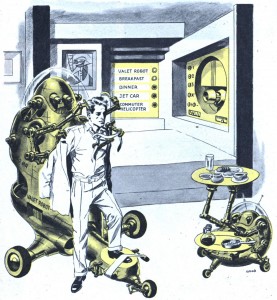
Or so they thought in 1957 in this Mechanix Illustrated exposé.
The description of the robot valet and cook makes it seem like dependence would make us more of a slave to the technology then the other way around, but the robot cars and drones are closer to the mark. I can’t imagine anyone waving amicably at today’s red light cameras, although many drivers would probably welcome the hail of bullets fired in their direction.
The robot reporters prediction was about 50 years too soon, but we’re now starting to see them for statistics heavy topics like fantasy sports.
The most amusing part is about GE’s role in the upcoming cyber serfdom.
Most remarkable is General Electric’s new Yes-Man, a master-slave manipulator of incredible dexterity. Any movement the human master makes with his hand, even lifting a finger, is faithfully duplicated by the powerful slave machine. In a fantastic demonstration, Yes-Man fixed a girl model’s hair-do and applied cosmetics, all with the gentle touch of a woman’s hand.
Of course, it took awhile, but we know now that the GE Yes-Men did in fact come into existence and took over the entire company. For the past decade they apparently had the same short term forecasting skills as Mechanix Illustrated.
According to the article, this was all just a walk in the park for cybernetics pioneer Dr. Norbert Wiener who envisioned the Age of Robots unfolding before us. Well, he didn’t exactly deliver the Jetsons, but Wiener did leave us with some insights to give us some pause in our pursuit of a future with digital autonomy.
Finally the machines will do what we ask them to do and not what we ought to ask them to do. In the discussion of the relation between man and powerful agencies controlled by man, the gnomic wisdom of the folk tales has a value far beyond the books of our sociologists.
In short, it is only a humanity which is capable of awe, which will also be capable of controlling the new potentials which we are opening for ourselves. We can be humble and live a good life with the aid of the machines, or we can be arrogant and die.
I foresee increased demand for a robot wife.
The robot reporters of the future presumably won’t botch the hypertext link.
Jonathan, you may be right, especially in Japan where solo weddings are all the rage this season.
They are having some issues with their robot dogs over there. Now that Sony doesn’t sell or support them anymore, they are all slowly failing. Talk about yesterday’s future dying out. It all sounds like a demoralizing Philip K. Dick storyline or something.
Of course, there will be unexpected but entirely predicable developments…
http://www.zazzle.com/fraternal_league_of_robotic_person_poster_16x20-228866313647234236
From the 1957 article: “With suitable telephone and television circuits, master and slave can be thousands of miles apart. Thus a doctor in New York could perform an operation, via Yes-Man in Los Angeles!”
From the Intuitive Surgical website: “A. Intuitive Surgical’s goal is to extend the benefits of minimally invasive surgery to as many patients as possible. Our strategy to achieve this includes the development of products that allow doctors to rapidly expand their surgical techniques and capabilities. Our robotic surgical platforms currently allow surgeons to perform complex procedures using a minimally invasive approach.
In the interest of improving the surgeon training experience and expanding training programs, we are exploring telesurgery as a way to provide more convenient or expedient surgeon-to-surgeon proctoring and coaching. We see telesurgery as a means to allow surgeons to learn and optimize their robotic-assisted surgery skills under the guidance of leading specialists – with less disruption to clinical schedules due to travel ”” and therefore less impact on patients.”
I would imagine that ISRG is thinking of remote “proctoring and coaching” as a low-risk first step into telesurgery, and that actual telesurgery might not be too far off. One consideration is that truly redundant communication links should be provided, which is harder than it sounds.
I think that was one of the selling points of Windows Hololens – virtual remote surgery.
I’m sure Michael Kennedy can address this issue better than me, but I think autonomous robot surgeons are a long, long ways off. For the most general health and wellness issues maybe, like the WebMD symptom checker.
Nothing autonomous about the ISRG product, as I understand it, it is merely a highly precise manipulator that follows the human surgeon’s movements translated to a much smaller scale…hence, a “robot” only in the same sense as the 1957 GE product that was mentioned. Telesurgery would just extend the visual and control links over long distances.
Note the year 1957 when science fiction began it’s prosperous introduction into the forefront of Americana. I recall many of these type of articles in Popular Science and so many other similar journals. Robotics and robot cartoons made their way into the Saturday morning cartoon landscape, then magazines etc. It was a great way to introduce America into “automatronics”.